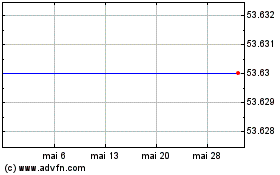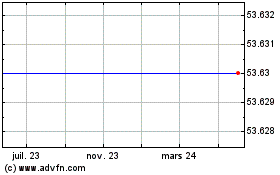Telecom Companies: The Market's Endangered Species
27 Juillet 2017 - 3:29PM
Dow Jones News
By Akane Otani
In 2000, the S&P 500 telecom sector was stuffed with a dozen
companies, including Nextel Communications and WorldCom Inc. Today,
it is down to four.
This has created a strange dynamic for the group, which can
swing wildly when one or two of the companies change prices.
That was on display on Wednesday, when the S&P 500 telecom
sector climbed 3%, led by a 5% gain in shares of AT&T Inc.,
which reported a rise in profits for the second quarter after the
market closed Tuesday. The broader S&P 500 rose less than
0.1%.
The question now awaiting investors is: Will the sector
disappear entirely?
Telecom's influence on the broader S&P 500 has waned over
the years as companies have merged, been acquired or spun off
businesses -- leaving it the next obvious choice for a makeover,
investors and analysts say. Telecom, which is made up of Verizon
Communications Inc., AT&T, CenturyLink Inc. and Level 3
Communications Inc., is the smallest of the S&P 500's 11
sectors.
"Right now when you look at what telecom is doing, it's usually
just one of four stocks moving," said Art Hogan, chief market
strategist at Wunderlich Securities. "It makes a great deal of
sense to look at the sector."
A wave of possible changes to the S&P 500's classifications
could overhaul the group and reshuffle billions of dollars in
index-tracking funds that stay aligned with the makeup of the
S&P 500. S&P Dow Jones Indices and fellow index provider
MSCI Inc. said earlier this month that they are considering rolling
out a new sector, the communication-services sector, that would
fold telecom stocks in with select media, entertainment,
consumer-internet and digital- services stocks.
Telecom was 2.1% of the S&P 500's overall market
capitalization as of the end of June, according to S&P Dow
Jones Indices, down from 8.7% in 1990.
Over that time, giants like the former SBC Communications bought
Ameritech Corp. and AT&T Corp. before rebranding itself as
AT&T, while GTE Corp. merged with Bell Atlantic and renamed
itself Verizon Communications. More recently, CenturyLink has been
preparing to complete its purchase of Level 3 Communications, a
move that would further reduce the number of stocks in the telecom
sector.
Much of the deals activity in the telecom sector reflects the
pressures the industry has faced.
The sector "is changing as landlines disappear, smartphones
become more affordable and internet connections become increasingly
important," S&P Dow Jones Indices and MSCI said in a statement
explaining their rationale for the proposal. "Companies in the
sector are adapting by diversifying into internet services, cable,
media content and other areas by consolidating with other
companies."
The flagging telecom sector could get a boost if the two index
providers decide to move some internet-focused companies out of the
existing consumer-discretionary and information-technology
sectors.
Many such stocks have rallied this year as investors bet on
fast-growing firms. Shares of Facebook Inc. have jumped 44% this
year, while eBay Inc. has added 25% and Google parent Alphabet Inc.
has risen 22%. Meanwhile, the S&P 500 telecom sector has shed
13%.
Investors, asset managers and analysts have said that the
telecom sector is too narrowly defined and that it was due for a
review, said David Blitzer, head of index policy and governance at
S&P Dow Jones Indices. There doesn't appear to be any
exchange-traded funds that exclusively track the telecom sector,
Mr. Blitzer said.
Instead, funds like the Vanguard Telecommunications Services
ETF, the iShares U.S. Telecommunications ETF and the SPDR S&P
Telecom ETF track a broader and larger group of stocks, including
companies like U.S. Cellular Corp. and Boingo Wireless Inc. that
don't belong to the telecom sector.
Still, there are no guarantees of what names, if any, will be
incorporated into a new communication-services sector. S&P Dow
Jones Indices and MSCI are still weighing whether companies that
focus on search engines, social media and mobile messaging, as well
as web hosting and web-design services, should be folded into the
sector, they said.
The two index providers are soliciting feedback on the proposal
from members of the investment community between July and September
29. If they decide to move forward, they would announce the changes
by November and roll out the changes sometime in 2018, S&P Dow
Jones Indices and MSCI said in a statement.
(END) Dow Jones Newswires
July 27, 2017 09:14 ET (13:14 GMT)
Copyright (c) 2017 Dow Jones & Company, Inc.
Level 3 Communications, Inc. (delisted) (NYSE:LVLT)
Graphique Historique de l'Action
De Oct 2024 à Nov 2024

Level 3 Communications, Inc. (delisted) (NYSE:LVLT)
Graphique Historique de l'Action
De Nov 2023 à Nov 2024



